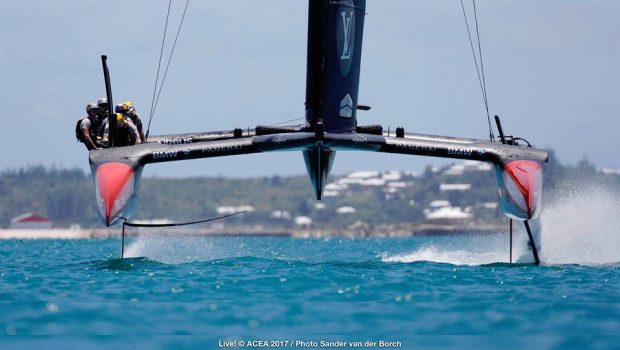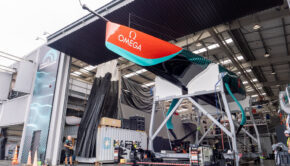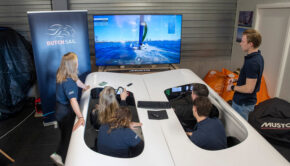Sailing in the America’s Cup Class
Published on June 20th, 2017
JB Braun lives on the pointy end of the sport, working with North Sails in the design and development of their sail products. But he’s also entrenched with Oracle Team USA, supporting their performance team, and is likely working overtime this week to help the Defender catch up with the very fast Emirates Team New Zealand.
Scuttlebutt editor Craig Leweck caught up with JB before the 35th Match to better understand what it takes to sail the America’s Cup Class boat.
Ever since the 2013 America’s Cup, we’ve been watching foiling boats with some intensity. However, the development clearly remains ripe, if only for the fact we see the best sailors struggling at times. Why is that?
If the question is why are best sailors in the world still not able to consistently foil the boats without moments where they crash down, the answer is the boats remain very hard to sail. We could design and make boats that do fly and are very stable, however, we’re constrained a little bit by the America’s Cup Class rules.
The way the rule has been designed and orchestrated has provided an opportunity where the users still have input on how the boats foil, and specifically that we’re not allowed any feedback loops. You can’t measure something on the boat which dictates how the foiling is managed. The flight control is still all done manually. It’s assisted by hydraulics, but it’s initiated by the manual interventions, so that the sailors still are connected to the boat.
Certainly, if you had a blank sheet of paper and you wanted to have stable flight, you could do it but it would be done differently. The rules really are predicating how the boats must be sailed.
Much has been said about the need to accumulate power to fuel the hydraulic systems, but at times these systems appear to struggle. With races often determined by splashdowns, how much of that is on the sailor, and how much of that is on the systems?
I would say those things go hand in hand, a little bit. The systems are dovetailed to the sailors because they have helped design these systems. But the design and use is all based on the time sailing the boat, which for all the teams was limited.
For example, earlier in the series when it was fairly windy at the top end of the wind range, I don’t think the sailors had really raced in that condition. So the loads and all the details of sailing the boats in that condition, it was really some of the first experiences. You could be out in that wind, but really racing and pushing the boat, it doesn’t happen until you’re in combat and pushing it.
The loads and the systems get developed as a result of trying it and saying, “Oh, well, it’s not working. Why isn’t it working? I needed it to do this.” And then you’d go back and look at what happened or what the scenario is and look at redesigning it, or if it wasn’t a redesign, the sailors could maybe manipulate it in a different way.
So there’s a lot of that back and forth between the system design and the sailors’ needs. And the sailors are really driving that development. Now, as a designer you can say, “Okay, here’s what it’s intended to do and here’s the range of what it does.” But then you need to go out and test it and really see the dynamics of the boat.
Probably not much in a typical chandlery for these boats.
Sailing the boats get very complicated with all the systems because you’re doing maneuvers and you’re relying on these Programmable Logical Controllers that are orchestrated by the crew.
Let’s talk about the daggerfoils. They are going up and down, and when they go down and break the surface of the water, can that moment vary to impact the boat’s performance?
Absolutely. That’s a very great point, because that’s one of the things you look at when you’re designing the foils, is clearing. How quickly can the foil get attached flow, and start operating as a foil? Because the boat’s not only going forward, but the board is being sucked into the water, or you’re pushing it into the water, which adds a whole another flow dynamic. It’s a short period of time, but when the flow is not attached, you add a lot more drag.
So the sequence about how fast you push the board into the water, how quickly it clears, meaning when it goes in the water, it sucks some air with it. Determining how long that air stays around the foil is part of the design process. This what all the teams have looked at for not only top performance but also maneuverability. You could have a very fast foil, but for what the foil must do in a race, it may not prove to be the best foil.
And staying up on the foils during maneuvers can determine winning and losing.
It’s very delicate. Downwind is a little easier because the boats are going faster, so you have a lot larger margin of error to foil depending on what size daggerfoils are used. They’ll foil maybe as low as 13, 14 knots with the light air foils and they’ll start foiling at about 18 knots with the heavy air foils.
So if you are going 30 or 40 knots downwind, you have a much larger margin of boat speed to play with before the foil becomes ineffective at lifting the boat out of the water. However, going upwind, the speeds are slower so the margin to maintain flight is narrower, so you are more likely to see the boats fall off the foils upwind than you are downwind because of that speed delta.
The other goal is getting level flight, balancing the load between the rudders and the daggerfoils in the turns would be a big learning experience to reliably do the foiling tacks in the lighter air. I think they’re getting pretty good at when the breeze is on and the boat speeds are up, but when your boat speed is closer to the minimum speed, the board will lift. It’s a much more delicate balance there.
Is there a lot going on with the daggerfoil angle during a tack or gybe?
Yes. When they drop the daggerfoil, there are preset angles through a turn. This is done by how the bottom of the board rotates fore and aft which changes the angle of attack of the horizontal section of the board. Just like an airplane wing, this is what lifts and manages the boat out of the water.
In a tack, when the board initially goes in, it is either neutral, meaning that there is either no lift or maybe even sucking down slightly. This approach helps for it to be easily pushed down. But then as it gets close to the bottom and the boat starts to turn, now it needs to take on more and more lift. So as the boat is turning, the angle of attack of that foil will increase until it gets to the point where it is taking on all of the load and thus needing to generate the lift to keep the boat up.
What’s critical is synching the changing board angle in the turn with the boat speed. If the boat is going slower, the angle will need to be greater on the horizontal part of the foil, so the rate would have to come back. And if the boat is going faster, then you need less rate. So it is contingent on the boat speed.
The speed at which the boats are being tacked, particularly the kiwi boat, is mind blowing.
You only have so much stored energy and boat speed, and you have the lower end where you foil, depending on the size of the daggerfoils. Maybe 13 knots in light air and 18 knots in heavy air. So you have this margin of living on the foils, but then you must deal with all the drag.
The problem is the boats are going so fast upwind, which we have seen generate upwards of 55 knots of apparent wind. So through the turn, if the wingfoil and jib are not generating lift, they are creating significant drag which slows the boat very quickly, especially upwind, through the turn. So you’re trying to use your boat speed and the inertia of the boat to maintain your speed and then get the power on as quick as you can.
One of the things we are seeing is different tacking techniques to where you try to spin through the wind really quickly to stay on the foils, but in the lighter wind, you have to head off so far away from the wind to maintain your foiling, that it may be better to slow the turn and elongate it to windward and have a touch-and-go with the hulls, which in the end may lower your boat speed but deliver better VMG. We are paying attention to the different wind ranges to see which of these different techniques will pay.
I suspect it’s hard for most people to fully appreciate what it takes to sail these boats.
The boats are fast and things happen very quickly… these guys have their hands full. It’s amazing how skilled they are at what they’re doing. It’s no easy task to sail these boats. They’re very complicated. The sailors are like finely trained fighter pilots and athletes. There are very few people that have experienced this type of sailing.
Where do your eyes go when you are watching a race?
I always look at the sails. The wing and the jip sail, that’s my go-to, to see how that’s set up. How deep or flat or twisty or where they’re trimming off center line. All those little nuances of trim. That’s where I focus on.
Because there are a lot of differences?
Yes. There’s a lot of differences and a lot of different theories. As you can see these boats, it’s very dynamic. So there’s a lot of things changing constantly. And that’s exciting for the sailors but also for the spectators because you’re like, “Wow! Look at what they’re doing. They’re doing things differently than the other guy.” But sometimes it’s hard to see when you are far away with your camera but other times when you zoom in and you’re like, “Oh!” You’ll see some differences.
Overall Results*
Emirates Team New Zealand (3) vs ORACLE TEAM USA (0)
* Scoreboard: While the Challenger has won all four races, their match score is 3-0. The Defender, which won the Qualifiers held on May 26-June 3, began the series with a one point advantage. As the rules detail, the Challenger would carry a one point disadvantage (ie, minus 1), meaning they will need to win eight races to take the trophy whereas the Defender need only win seven races.
Schedule: The dates of the Match extend from June 17 to 28, though will end earlier when a team scores 7 points. The next race day is June 24 and will continue daily thereafter until there is a winner.
Event details – Results – Facebook
Here are the answers to these questions…
• What is the racing schedule? Click here
• What is the competition format? Click here
• How can I watch the racing? Click here










 We’ll keep your information safe.
We’ll keep your information safe.